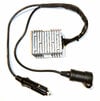Does this attach to the existing socket? I'm not necessarily looking to DIY (DIM?), I'm not very handy electrically and willing to pay for something that works.
I'm not aware of a ready-made product that plugs into the cigarette lighter socket, regulates the voltage and provides that to another cigarette lighter socket. It wouldn't be terribly hard to construct something like that, but does require some handiness with electrical construction.
If you know someone who could help , and without starting from scratch, this might be a good starting point product:
https://a.co/d/bzXv4KO
It has a digital voltage monitor for the existing lighter socket, and then provides regulated USB 5 volt plus
unregulated extension sockets. What I would think of doing with this would be to buy it, open up the main box and remove at least one of the three extension sockets and/or the collection of USB paraphernalia in order to make some room inside the box. At that point, insert a regulator like the one shown by
@Tam above, or something functionally similar to get the reduced voltage output.
Here, it's important to note that the normal voltage of an automotive "12 volt" system, while running and charging the battery, is more like 14.2 volts nominal. It can range from around 13.5 to over 15 volts. A robustly designed automotive accessories should handle up to about 18 or more but this is a very uncommon situation and many accessories aren't so robustly designed.
(I'm not really sure why Tesla's new lithium-ion battery system operates at such a relatively high voltage; I think it could have been set up lower but there's an issue of the internal cells having a relatively high individual voltage. Perhaps 4x series sells was too low and 5x was somewhat too high but deemed acceptable - I haven't looked into it further. I think they could have put in a regulator downstream but they didn't want the cost.)
Potentially a very simple solution to insert into the box, short of a real regulator, would be a couple of series-connected silicon diodes. Together these would drop roughly 1.4 volts from the existing (15.6V?) Ccgarette lighter output. Each diode would dissipate approximately 0.7 watts per ampere of load-draw current, so there's a minor consideration for adequate heatsinking. I'd also throw in at least 100 microfarads of capacitance at the second diode output. Again, this is not assuming that you will be doing the build yourself, but simply some working suggestions for a friend who has some electronics knowledge and experience.
I'll search a little more, but so far I haven't seen exactly the product you're werelooking for, a purpose built lighter socket regulator/stabilizer to deliver a nice clean ~14 volts to the output socket.
Final comment here - it will be interesting to see what Tesla does in the next generation vehicles, were they're rumored to finally adopt a 48 volt bus for the so-called low-voltage side. Almost certainly this will include a regulated 12 to 14 Volt secondary bus for compatibility with certain legacy and aftermarket accessories. So I think this weird 15.6 volt situation will go away in the foreseeable future.




